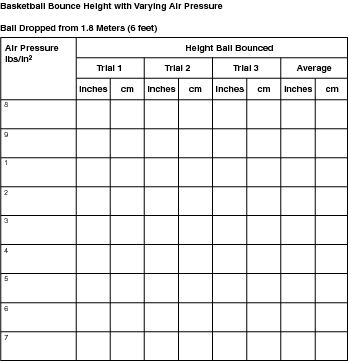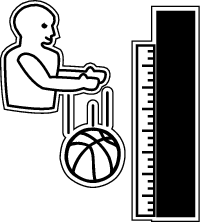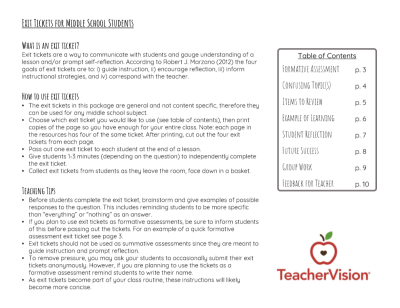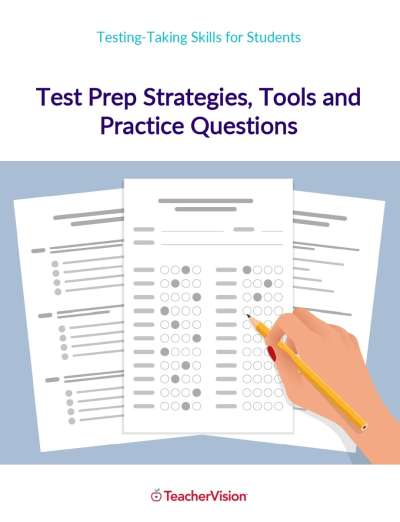Did you ever notice that some balls bounce better than others? Baseballs, for instance, don't have much bounce at all, except for when they land hard on the ground in front of you and jump up to nail your shinbone.
Footballs bounce, but you can never tell where they're going. Tennis balls bounce well, as do soccer balls and basketballs. But did you ever notice that some of the same types of balls bounce better than others?
Having the right ball for the game you're playing is important. Having a ball that does what it's supposed to do is equally important. In this section, we'll explore why some balls bounce better than others, and what you can do to assure that the ball you're using is in top condition for the game.
So What Seems to Be the Problem?
If you have a ball that doesn't bounce properly, the immediate problem is that it will affect your game. The problem we'll attempt to solve during the course of this experiment, however, deals with air pressure.
Air pressure, simply put, is the push that air has against all surfaces that it touches. The more air there is in a contained area, the greater the air pressure.
Specifically, we'll try to determine what amount of air pressure in a basketball makes the ball (and hopefully the person using the ball) perform best.
In the next few sections, you'll learn a little bit about what air pressure is, and some of the effects it has on us and on our surroundings.
Air-as in the stuff we breathe-is matter. It has mass, or weight, and volume, meaning that it takes up space. It's funny to think about air as having mass and volume. You can't see it, and you don't sense that you're running into it as you run or walk. It's easier to get a sense of air and air pressure when you think of air that is contained within something, such as your basketball, an air mattress, or a bike tire.
Air is composed of different gases, including nitrogen, carbon dioxide, water vapor, oxygen, and others. All of these gases are composed of particles, or more scientifically, molecules, and they're all in constant motion.
As the molecules move about, they come in contact with surfaces of objects. The molecules push and press on those surfaces, exerting pressure on them.
It's that pressure that allows your basketball to keep its round shape and remain hard and bouncy. If air escapes from the ball, the pressure inside the ball changes. The problem you'll attempt to solve while doing this experiment is how these changes in pressure affect the ball.
If you like the title of this section, "Does It Matter How Much Air Is In Your Basketball?" you could use it as the title for your project. Or if you prefer, you could use one of these titles:
- Getting the Bounce You Need from Your Basketball
- How Much Pressure Is Needed for the Best Bounce?
- How Air Pressure Affects the Bounce of Your Basketball
What's the Point?
Basketballs, along with other objects such as tires and footballs, are high-pressure products. This means that they require a lot of the force created by air pressure in order to get and stay fully inflated.
There are various measurements used for air pressure. Among them are pounds per square inch, millimeters of mercury, atmospheres, and pascals. In the United States, we measure this force using psi, or pounds per square inch. Conventional wisdom is that a basketball needs 8 psi to be properly inflated. A car tire, just for a comparison, needs 40 psi.
Most basketballs have inflation instructions printed right on them. Take a look and you'll probably see something like "INFLATE 7 to 9 LBS." For this experiment, a ball inflated to eight pounds per square inch will serve as the control. The same ball, but containing different amounts of air, will provide the variables.
Your challenge will be to determine if and how the amount of air inside your basketball causes it to bounce differently. You'll also determine whether the manufacturer's recommendation for the proper inflation rate gives the ball its best bounce.
What Do You Think Will Happen?
If you've ever pumped up a bike tire, an air mattress, or a ball, you've had some experience with air pressure. Blowing up a balloon, which nearly everyone has done, is another example of air pressure.
Excessive contained air can cause such force against an object that the object bursts. This happens frequently with balloons, which are fairly fragile. It happens less frequently with basketballs, which are sturdier objects, but it can occur.
A loss of air pressure within an object such as a ball or tire, however, also can cause problems.
Think about observations you may have made that relate to air pressure. Does your bike ride as well when one of the tires (or maybe both) has lost air? Does your ball bounce as well? If you've ever played tennis with a ball that's lost pressure, you'll understand why they're referred to as "dead" balls. A dead ball hits the court and drops, as if it is-indeed-dead.
Using your experience and observations, come up with a hypothesis concerning your basketball and whether the amount of air in it will affect the way it bounces. Do you think that increasing the level of air even above the manufacturer's instructions will cause -it to bounce better? What about if there's less air in it than recommended?
Materials You'll Need for This Project
You need only three things-with two optional, additional items-to conduct the experiment for this project. They are:
- One basketball
- One air pump with a pressure gauge
- One tape measure or meter stick
- One long piece of paper and tape (optional)
It's a good idea to find someone to help you with this experiment, which involves dropping a ball and measuring how high it bounces. It would be possible-but very tricky-to do the experiment by yourself. Besides, basketball is always more fun with a friend!
Conducting Your Experiment
To begin the experiment, you'll test how high the basketball bounces when it's inflated to 8 pounds psi-the recommended level for most models. From there, you'll increase or decrease the air pressure by putting more air into the ball or removing some air.
The trick will be to add or subtract air in measured increments so that you can keep track of where the pressure is.
Be sure to drop the ball each time from exactly the same height. Starting from different heights will make the results of your experiment invalid.
Drop the ball close to a wall, so you can calculate on the wall the height of the bounce. It would be a good idea to make a paper measuring tape and hang it on the wall so you can better judge the height of the bounce. If you don't, be sure to watch closely how high the ball bounces and use your tape measure or meter stick to measure up to the spot on the wall at which the top of the ball stopped.
Make sure that your basketball is at 8 psi before you begin the experiment. Be sure to record both the pressure of the ball and the height of the bounce as you move through the following steps. You can record all of your results on the data chart found in the next section, "Keeping Track of Your Experiment."
Follow these steps to conduct your experiment:
- Drop a basketball inflated to 8 psi from a height of 6 feet (1.8 meters). Be sure that the bottom of the ball-not the top-is at the 6-feet line when you drop it.
- Observe, mark, and measure the height of the ball's bounce, remembering to measure at the top of the ball. Record your measurement.
- Repeat steps one and two twice, recording your results as you go.
- Using the air pump with the pressure gauge, increase the psi of the ball by one inch, to 9 psi, and repeat steps one through three.
- Using the needle of the air pump, force as much air out of the ball as possible, then repeat steps one through three.
- Increase the pressure within the ball to 1 psi, then repeat steps one through three.
- Increase the pressure within the ball to 2 psi, then repeat steps one through three.
- Increase the pressure within the ball to 3 psi, then repeat steps one through three.
- Increase the pressure within the ball to 4 psi, then repeat steps one through three.
- Increase the pressure within the ball to 5 psi, then repeat steps one through three.
- Increase the pressure within the ball to 6 psi, then repeat steps one through three.
- Increase the pressure within the ball to 7 psi, then repeat steps one through three.
Once you've completed all the steps, you'll need to average the height of the bounce recorded in each of the three trials for each step. To find the average, add the three measurements together, then divide the total by three.

Keeping Track of Your Experiment
As you conduct three trials for each of the basketball psi settings, you can record your information on the following data chart. Or you can make your own chart, if you wish.
Putting It All Together
Once you've recorded all your data onto the chart, you can plot it onto a graph, letting the x axis represent the pressure, and the y axis represent the height to which the ball bounced when dropped from 1.8 meters, or 6 feet.
Once you've completed your graph, you'll be able to clearly see if your findings prove, or disprove, your hypothesis.

Further Investigation
If you're a hands-on kind of person, and you enjoyed doing this experiment, you can think about taking it a step or two further.
You could do this by testing the ball in the same manner, but varying the temperature conditions. You might try bouncing the ball outside on a very cold day, and then, using the same psi settings, record the height of bounces in a nice, warm house.
You also could test balls made of different materials, but inflated to the same level of pressure. Or you can come up with your own ideas for similar experiments.
Help students get a "handle" on understanding air pressure
Students observe how different levels of air pressure affect the performance of a basketball in this printable science activity. This group activity is a perfect hands-on science project for a unit on states of matter, and will help students understand and implement the scientific method, as well.
Looking for project-based learning?
Check out our collection of hands-on projects that combine math, ELA, and science concepts with 21st Century and social-emotional skills!



